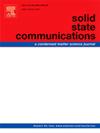Theoretical study of intrinsic ferromagnetic to antiferromagnetic switching in two-dimensional Fe/CoCl2 monolayers encapsulated in UiO–67 MOF via edge termination
IF 2.4
4区 物理与天体物理
Q3 PHYSICS, CONDENSED MATTER
引用次数: 0
Abstract
Density Functional Theory (DFT) calculations are used to study the magnetic properties of two dimensional (2D) Fe/CoCl2 structures recently synthesized inside a derivative of UiO–67 Metal–Organic Framework (MOF). Both structures found stable in their high spin ground state with large intrinsic magnetic moments at each metal site. The calculated magnetic moments of Fe/CoCl2 structures are on average 3.75 /Fe and 2.30 /Co. These values are close to what is expected for Fe2+/Co cations in a d6 and d7 electronic configurations with four and three unpaired electrons in their high spin states respectively. According to the calculated nearest neighbor (NN) magnetic exchange coupling constants (J’s), superexchange interactions among metal cations are FerroMagnetic (FM) in FeCl2 and AntiFerroMagnetic (AFM) in CoCl2. All interactions become AFM in the presence of [Fe/CoCl4] groups at the outer edge of both structures within the MOF’s pore environment. Switching the magnetic interactions from FM to AFM by means of edge termination can have several important applications in spintronic devices and magnetic memory devices based on AFM materials.
UiO-67 MOF封装二维Fe/CoCl2单分子层经边缘终止的本征铁磁到反铁磁切换的理论研究
利用密度泛函理论(DFT)计算研究了最近在UiO-67金属有机骨架(MOF)衍生物内合成的二维(2D) Fe/CoCl2结构的磁性能。这两种结构在高自旋基态下都是稳定的,在每个金属位点上都有大的本征磁矩。计算得到的Fe/CoCl2结构磁矩平均为3.75 μβ/Fe和2.30 μβ/Co。这些值接近d6和d7电子构型中Fe2+/Co2+的预期值,d6和d7电子构型中分别有4个和3个未成对电子处于高自旋态。根据计算的最近邻(NN)磁交换耦合常数(J 's),金属阳离子之间的超交换相互作用在FeCl2中为铁磁(FM),在CoCl2中为反铁磁(AFM)。在MOF的孔隙环境中,在两种结构的外缘存在[Fe/CoCl4]2−基团时,所有相互作用都成为AFM。利用边缘终止将磁相互作用从调频转换为AFM,在基于AFM材料的自旋电子器件和磁存储器件中具有重要的应用价值。
本文章由计算机程序翻译,如有差异,请以英文原文为准。
求助全文
约1分钟内获得全文
求助全文
来源期刊

Solid State Communications
物理-物理:凝聚态物理
CiteScore
3.40
自引率
4.80%
发文量
287
审稿时长
51 days
期刊介绍:
Solid State Communications is an international medium for the publication of short communications and original research articles on significant developments in condensed matter science, giving scientists immediate access to important, recently completed work. The journal publishes original experimental and theoretical research on the physical and chemical properties of solids and other condensed systems and also on their preparation. The submission of manuscripts reporting research on the basic physics of materials science and devices, as well as of state-of-the-art microstructures and nanostructures, is encouraged.
A coherent quantitative treatment emphasizing new physics is expected rather than a simple accumulation of experimental data. Consistent with these aims, the short communications should be kept concise and short, usually not longer than six printed pages. The number of figures and tables should also be kept to a minimum. Solid State Communications now also welcomes original research articles without length restrictions.
The Fast-Track section of Solid State Communications is the venue for very rapid publication of short communications on significant developments in condensed matter science. The goal is to offer the broad condensed matter community quick and immediate access to publish recently completed papers in research areas that are rapidly evolving and in which there are developments with great potential impact.
 求助内容:
求助内容: 应助结果提醒方式:
应助结果提醒方式:


